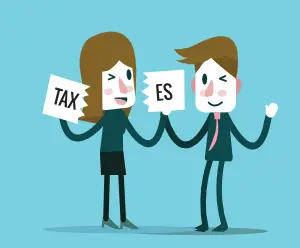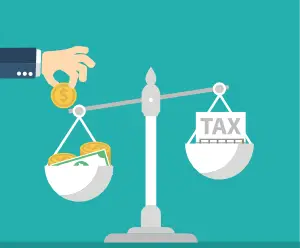
Understanding the IRS Substitute for Return
Click to ask Mike Ask Mike The Internal Revenue Service (IRS) Substitute for Return (SFR) is a term many taxpayers

In the intricate landscape of U.S. tax law, two provisions stand out as crucial instruments to shield taxpayers from the consequences of their spouses’ financial actions: Injured Spouse Allocation and Innocent Spouse Relief. These provisions address distinct scenarios and offer protective measures, yet they are often confused due to their similar-sounding names. To unravel the complexities and provide a comprehensive understanding, let’s delve into the differences, eligibility criteria, filing procedures, and the broader implications of Injured Spouse Allocation vs. Innocent Spouse Relief.
Injured Spouse Allocation vs. Innocent Spouse Relief: Understanding the Differences
Understanding Injured Spouse Allocation:
Injured Spouse Allocation is a provision designed to safeguard a taxpayer’s share of a joint tax refund when it is at risk due to the financial obligations of their spouse. The primary focus is on the fair distribution of tax refunds, ensuring that an innocent spouse is not unduly penalized for the financial liabilities of their partner.
Eligibility Criteria: To qualify for Injured Spouse Allocation, specific eligibility criteria must be met. Firstly, the taxpayer must have overpaid their taxes or have a refund due. Secondly, the debts or obligations causing the offset must be solely attributed to the non-injured spouse.
Filing Procedure – Form 8379: The process of obtaining Injured Spouse Allocation involves filing Form 8379, aptly named “Injured Spouse Allocation.” This form is submitted along with the joint tax return and serves as a formal request for the allocation of the tax refund. It requires detailed information about the income, deductions, and credits of both spouses, enabling the Internal Revenue Service (IRS) to make an informed determination.
Implications for Families: Injured Spouse Allocation goes beyond being a mere procedural step in tax filings; its implications are profound for families. By ensuring that the innocent spouse receives their rightful share of the tax refund, this provision contributes to the overall financial stability of the household. It prevents an undue burden on the innocent party and promotes fairness in the distribution of financial resources.
Understanding Innocent Spouse Relief:
Innocent Spouse Relief, while sharing a common theme of protecting innocent parties, addresses a broader spectrum of issues. It comes into play when one spouse seeks relief from joint and several liability for tax, interest, and penalties arising from errors or omissions on a joint tax return.
Eligibility Criteria in Detail: The eligibility criteria for Innocent Spouse Relief are more intricate. Firstly, the joint return must have been filed. Secondly, the errors or omissions leading to the tax liability must be solely attributable to the non-requesting spouse. Lastly, the requesting spouse must not have had knowledge or reason to know about the inaccuracies.
Filing Procedure – Form 8857: To initiate the process of seeking Innocent Spouse Relief, the taxpayer must file Form 8857, titled “Request for Innocent Spouse Relief.” This form is comprehensive, requiring detailed information about the circumstances surrounding the inaccuracies on the joint return. It delves into the nature of the errors, the financial situation of both spouses, and the impact of the tax liabilities on the innocent spouse.
Compassion in Taxation: Innocent Spouse Relief introduces a compassionate dimension to the tax system. It recognizes that situations may arise where one spouse, often due to factors beyond their control, finds themselves facing the consequences of errors or intentional misrepresentations made by the other spouse. This provision seeks to balance the scales of justice within the tax system, acknowledging the potential injustice of holding both parties accountable for the actions of one.
Key Differences Explored:
Nature of Issue:
Type of Obligation:
Conclusion:
The distinctions between Injured Spouse Allocation and Innocent Spouse Relief are not just technicalities; they carry significant implications for taxpayers and their families. As individuals navigate the complexities of the U.S. tax code, these provisions serve as essential safeguards, ensuring fairness and equity in the face of joint tax liabilities.
Injured Spouse Allocation protects against the encroachment of financial obligations on a tax refund, safeguarding the innocent spouse’s share. On the other hand, Innocent Spouse Relief goes beyond financial considerations, recognizing the need for relief when one spouse is genuinely unaware of the issues leading to tax liabilities.
In conclusion, the understanding of these provisions is crucial for taxpayers seeking to make informed decisions and protect their financial interests. As both Injured Spouse Allocation and Innocent Spouse Relief have specific requirements, deadlines, and implications, individuals are encouraged to seek professional advice or carefully review IRS guidelines. In doing so, they can navigate the complexities of the tax system with confidence, ensuring that these protective measures serve their intended purpose of providing relief and justice within the realm of taxation.
You can now ask our AI assistant any questions you have about your tax debt or any tax-related issues. Whether you’re unsure about payment plans, need clarification on penalties, or want information on how to resolve your tax situation. Our AI is ready to assist you with all your tax-related concerns.

By interacting with our AI assistance, you agree to our terms & conditions. Enjoy our AI Tax Assistant responsibly.
Ask me any questions...
Related Posts

Click to ask Mike Ask Mike The Internal Revenue Service (IRS) Substitute for Return (SFR) is a term many taxpayers

Click to ask Mike Ask Mike The Internal Revenue Service (IRS) Substitute for Return (SFR) is a term many taxpayers

Click to ask Mike Ask Mike The Internal Revenue Service typically operates within a 10-year window, commencing from the

Click to ask Mike Ask Mike The Internal Revenue Service (IRS) operates within specific timeframes dictated by statutes of limitations

Click to ask Mike Ask Mike understanding the ins and outs of the 10-year statute of limitations (SOL) is essential.
Recent Posts

Click to ask Mike Ask Mike The Internal Revenue Service (IRS) Substitute for Return (SFR) is a term many taxpayers

Click to ask Mike Ask Mike The Internal Revenue Service (IRS) Substitute for Return (SFR) is a term many taxpayers

Click to ask Mike Ask Mike The Internal Revenue Service typically operates within a 10-year window, commencing from the

Click to ask Mike Ask Mike The Internal Revenue Service (IRS) operates within specific timeframes dictated by statutes of limitations

Click to ask Mike Ask Mike understanding the ins and outs of the 10-year statute of limitations (SOL) is essential.
Disclaimer: This is educational content, not legal, accounting, or tax advice.
This is a tax debt resource website, not to be used in lieu of a tax attorney or for legal advice. All information, Ai chat responses, articles, materials, and content are intended to inform users on a variety of tax topics. In no way is it intended to be construed as accounting, legal, tax, other services or advice. This site is not intended to be used to avoid tax penalties or tax debt that may be imposed by law. Terms and Conditions. Your use of this site constitutes acceptance of the following terms and conditions.
This is a tax debt resource website, not to be used in lieu of a tax attorney or for legal advice. All information, Ai chat responses, articles, materials, and content are intended to inform users on a variety of tax topics. In no way is it intended to be construed as accounting, legal, tax, other services or advice. This site is not intended to be used to avoid tax penalties or tax debt that may be imposed by law. Terms and Conditions. Your use of this site constitutes acceptance of the following terms and conditions.
© 2023 · Tax Debt Monster, Inc. All rights reserved

For all Tax Professionals that would like to partner up with us. By partnering with us, you’ll help us connect and make a positive impact in the tax community. Partner up with us and receive a complimentary Ai Tax Sidekick to help support your clients at no cost! Click here if you’re interested in our Partner-Up program

By interacting with our AI assistance, you agree to our terms & conditions. Enjoy our AI Tax Assistant responsibly.
How may I help you with your tax issue?